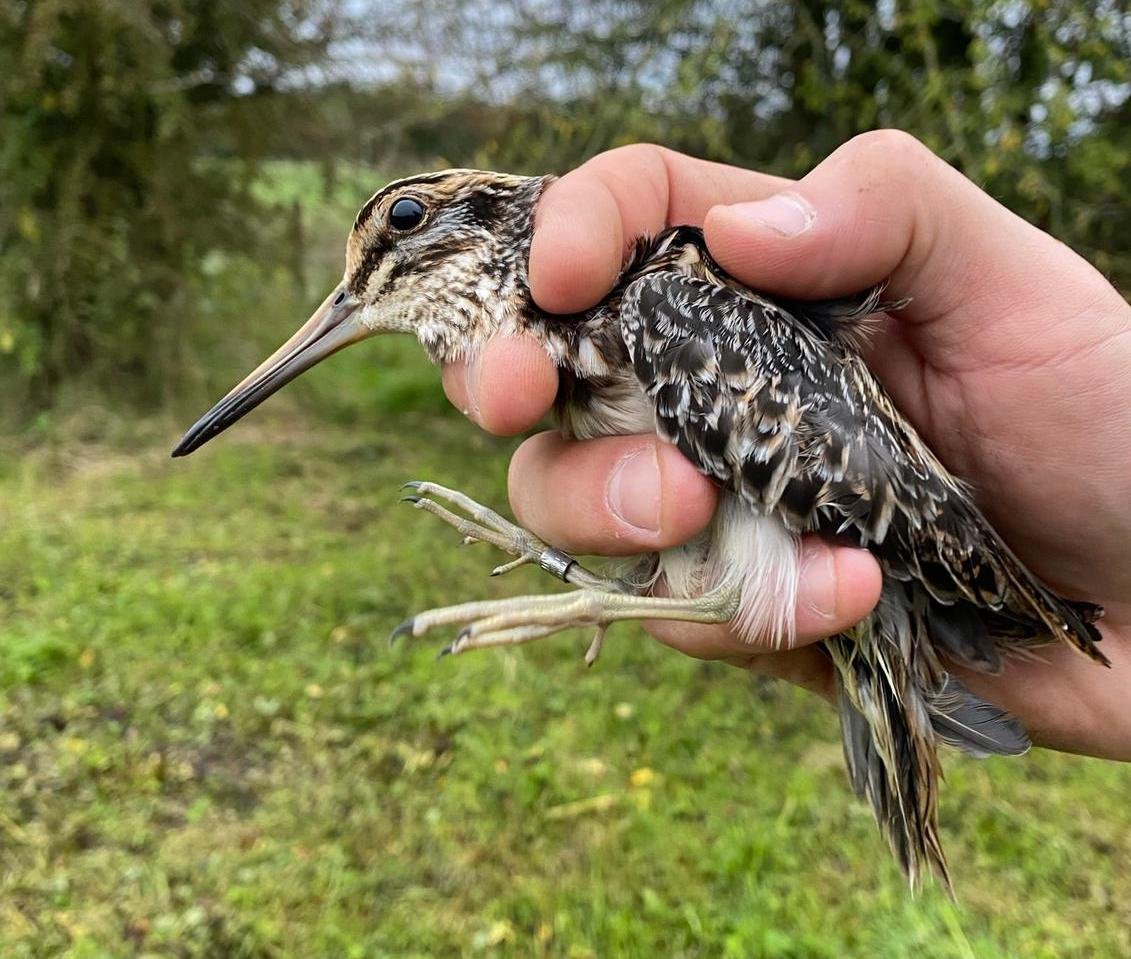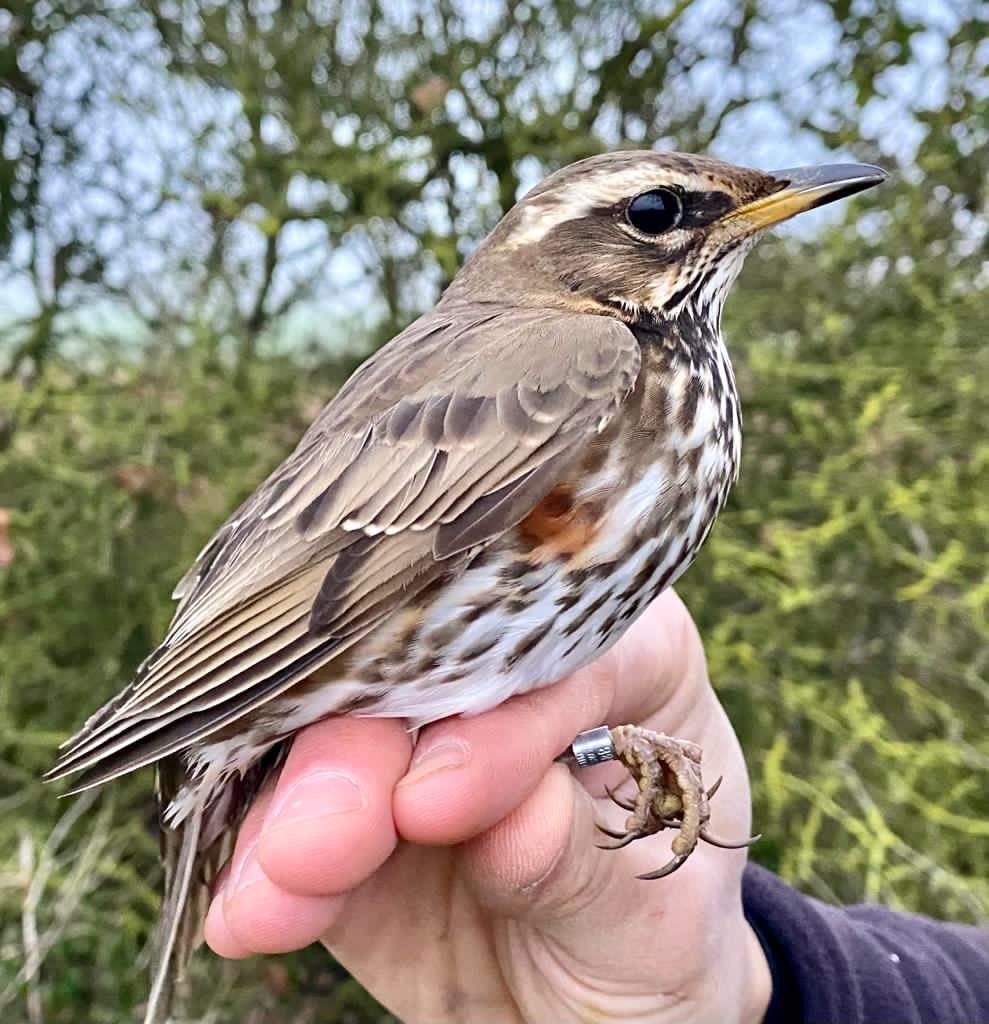Winter in the Water Meadows
BY: Oliver Fox, West Oxfordshire Farmland Bird Project
Cut off by floodwater, thick hedgerows and the fast-flowing river, the water meadows at Southrop form the perfect haven for wildlife in winter, where rich grasslands, flooded ponds and berry-laden bushes are found, hidden away from human disturbance.
The autumn hay cut in some of the fields has left a green flush of new plant growth where fresh, spikey sedge leaves rise up above the flood. Muddy edges around the gateways, tractor ruts and the wader scrapes provide hiding places for two common, yet elusive, wintering wading birds. Common Snipe are the most abundant of the two, arriving in the flooded meadows in October and staying all winter if the ground stays soft enough for them to feed. Snipe use their incongruously long beaks to probe around in soft mud and detect worms and other soil-dwelling invertebrates, before pulling them up to the surface to eat. They are extremely camouflaged with cryptic brown plumage that perfectly matches the dead and decaying grasses in the meadow and are often not seen until flushed into the air at the last second. Surveys at Southrop in mid-winter can turn up over 30 Common Snipe in the meadows, all hidden in the rank grasses during the day and then dispersing to feed on more open areas and surrounding farmland each night.
Less common at Southrop, and even more difficult to see, is the Jack Snipe – a smaller relative of the Common Snipe with similar streaky-brown plumage that is tinged with iridescent purple on the back when seen up close. Jack Snipe have proportionally smaller beaks too and so feed on prey closer to the soil surface. They stay tucked away in the grass tussocks even when you approach, pretending they have not been seen. In colder spells, when the ground is frozen solid, the Snipe, and their Jack Snipe cousins, are forced to move southwards in search of better, softer, feeding areas. Some end up in France and Spain, while others fly much further and reach wetlands in Senegal, Mali and Guinea-Bissau.
Far more obvious winter visitors to the meadows are the wildfowl which congregate on any open water in the area, particular on gravel pits and lakes in the nearby Cotswold Water Park complex. Flooded fields at Southrop attract the ubiquitous Mallard but also rarer species like Gadwall, Teal and Tufted Ducks. Although wary to any potential predator or hunter, the ducks and swans find the ideal hideaway at Southrop, feeding on the rich plant life in the meadows before moving on to other wetlands.
Circling the water meadows, the high hedgerows that supported hundreds of breeding and migrating birds in summer and autumn now offers a myriad of resources for different species, many newly-arrived from further north. Chattering gangs of Redwings and Fieldfares – thrushes from Scandinavia and relatives of our Song Thrushes and Blackbirds – swirl around the sky before diving en masse into the bushes to find food and safe roosting sites. As the larder of blackberries, hawthorn and blackthorn berries is depleted later in the winter, these thrushes move out onto the open fields to feed on insects and worms, before returning to the safety, and relative warmth, of the bramble patches to spend the cold winter nights. At the base of these scrubby hedges is a broad skirt of high grass and weedy vegetation, left uncut by the autumn mowing. These bounteous field boundaries support a wealth of insect and other wildlife through the colder months, the grass clumps harbour ant colonies, burrowing solitary bees, hibernating queen bumblebees and a massive number of spiders. Field Mice, Common Shrews and Field Voles make tunnels in the matted vegetation to access nests and larders of seeds and berries.
Local wildlife refuges like the meadows at Southrop attract more uncommon visitors too, and previous winters have played host to Otters along the river, feeding on the fast-moving Brown Trout and now a familiar site on the Thames and its tributaries. Warmer winters as a result of global warming means that birds that previously would not have been able to survive can now spend all winter in southern England. Great White Egrets are established as a breeding bird and turn up occasionally at Southrop, in addition to the now-common Little Egrets. Green Sandpipers and Oystercatchers appear more irregularly and benefit from the wader scrapes that have been made in the middle of meadows.
Our team will be out exploring the water meadows throughout the remaining winter months to record the incredible wildlife found there, documenting the birds that are surviving from year to year and discovering unexpected arrivals that continue to surprise us.
West Oxfordshire Farmland Bird Project is run by a small team of volunteers to promote conservation, research and engagement with several local farmers and landowners. The project aims to help turn around the worrying declines in farmland bird populations seen in the UK over the last 50 years, through the promotion of wildlife-friendly management practices, environmental stewardship options and awareness of challenges faced by farmland birds throughout their life cycles. Over the last five years the project has worked on a large number of farms on the conservation of several key species, including Corn Buntings, Yellowhammers, Reed Buntings, Tree Sparrows and Barn Owls.
For more updates, follow the West Oxfordshire Farmland Bird Project on Twitter.






